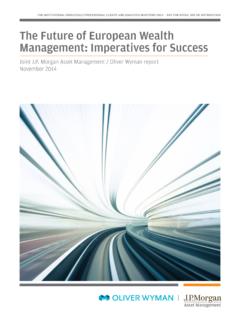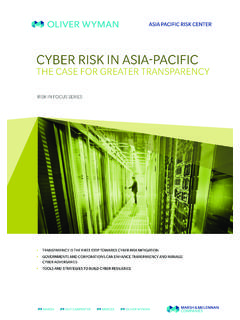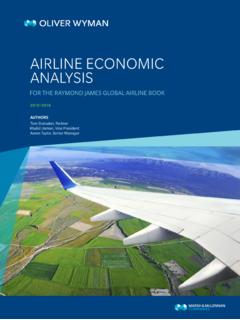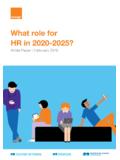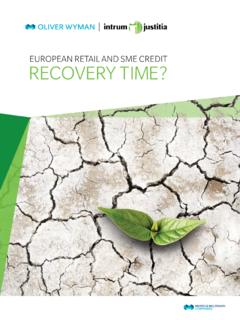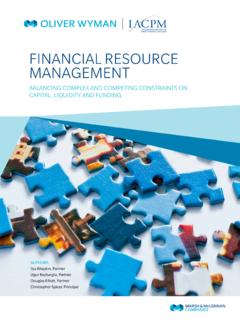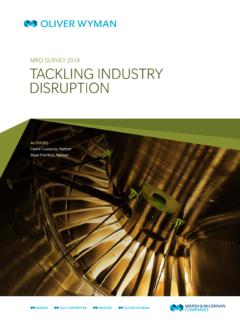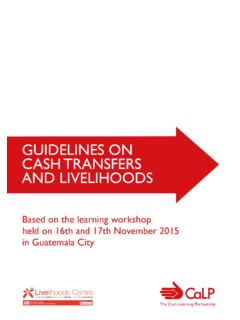Transcription of The Endgame for Commodity Traders - …
1 THE Endgame FOR Commodity TRADERSWHY ONLY THE BIGGEST AND DIGITALLY ADVANCED Traders WILL THRIVEA lexander Franke Roland Rechtsteiner Graham SharpThe Commodity trading industry is confronting a new, less profitable reality. After flatlining for several years, the industry s gross margins in 2016 dipped percent to $42 billion, our research shows. (See Exhibit 1.) This decline is setting off a torrent of deal-making and speculation that is transforming the face of Commodity trading with examples like Hong Kong-based Noble Group selling part of its business to the global energy trader , Vitol; oil trader Gunvor in talks with potential acquirers; and Swiss trading giant Glencore circling US grain trader Bunge.
2 The industry s Endgame has started. From oil to agriculture, building scale is proving to be the key competitive advantage for the future. The largest trading companies both diversified firms and those concentrating on a single Commodity use their financial strength to dominate the industry s largest, most profitable trades and invest in cutting-edge these Traders solidify their lead, the gap between those players with a critical mass in one or more commodities and the rest of the pack is widening. Within a few years, the industry will have a different profile one that is even more dominated by the biggest BIG MATTERSThe beginning of the Endgame started last year with the decline in margins and took off in earnest in 2017, as we predicted in our 2016 report, Reimagining Commodity Trading.
3 As companies tried to adjust to the industry s new economics, the clear edge for larger operations started to become evident. It didn t matter if Commodity Traders had sprawling global businesses diversified across various commodities or if they specialized in one or two. Either way, the larger Traders with more than $500 million in gross margins per Commodity class experienced 30 percent less gross-margin volatility on average than smaller Traders , our research shows. (See Exhibit 2.) ExHIBIT 1: Commodity TRADING S NEW REALITY After stabilizing the past several years, gross margins are saggingUS$ BILLIONS, 2010 2016, MARKET SHARES IN PERCENT Investor Soft Coal Niche Metals EU power and gas NA power and gas LNG Oil3520102 0 11392 012382 01338201444201544201642 Notes: Sum of products may not equal to total due to rounding; significance of shift overstated in graphic due to rounding; niche consists of emissions, Asia power and gas and exotics (weather).
4 Source: Oliver Wyman proprietary data and analysis2 ExHIBIT 2: Commodity TRADING GROSS MARGIN VOLATILITYL arger Commodity Traders have less gross margin volatility45%0%50%25%35%30%40%15%20%5%10 %% VARIATION FROM AVERAGE GROSS MARGIN, 2010 2016 GROSS MARGIN VOLATILITY DEPENDING ON SIZE AND FOOTPRINT BIG (> US$ 500 million gross margin per Commodity class) SMALL (< US$ 500 million gross margin per Commodity class) BIG (> US$ 500 million gross margin per Commodity class) SMALL (< US$ 500 million gross margin per Commodity class) Traders THAT FOCUS ON ONE Commodity CLASSTRADERS WITH CROSS Commodity FOCUS33%23%35%24%AverageSource: Publicly available data, Oliver Wyman analysisThis greater resilience permitted the industry s largest players to take greater risks, and in turn, that meant they could strike the bigger, more profitable, multi-year deals.
5 The same few names Glencore, Trafigura, Vitol, BP, and Shell repeatedly were the ones carrying out the industry s largest transactions. (See Exhibit 3.) As they did, their market share grew. In LNG and oil, for instance, Traders with at least $500 million in gross margins per Commodity class today capture two-thirds of the gross margins in each Commodity more than double what it had been six years before in some these advantages, even the biggest players are working to get even bigger. With increased scale and scope, they keep raising the bar for the industry on what it takes to compete. Today, leveraging proprietary information on Commodity flows across commodities and geographies to capture more value is becoming a prerequisite for staying in the game.
6 So is accessing attractive financing for large deals, superior shipping and logistics capabilities, and the ability to source and substitute commodities globally and accommodate fragmented wholesale customers. On almost every front, global Commodity trading giants are coping more easily with thinner trading margins in increasingly mature and less volatile Commodity markets, stretching from the developed countries of Europe and North America to emerging economies in Asia. But to achieve these standards, it takes investment that some players can t RETURN ON INVESTMENTOne reason for the better economics: The largest trading operations are reaping the rewards of years of investing in building out their global reach and capabilities while 3 ExHIBIT 3.
7 Commodity TRADING S BIG DEALSThe industry s biggest Traders repeatedly secure the industry s largest deals10 OF THE LARGEST DEALS IN 2015, 2016 AND 2017 COMPANYDATEDEALSIZE /VALUEV itolSep 2017 Vitol provides oil-backed loans to state-controlled companies in Kazakhstan$5 billionVitolApr 2017 Vitol makes advance payments for crude to state-owned oil company in Kazakhstan$3 billionVitolJan 2017 Vitol funds refined products-backed loan to National Iranian Oil Co. $1billionGlencoreNov 2017 Glencore completes silver streaming deal (sale of future output) sale of future silver output to Silver Wheaton Corp$900 millionGlencoreMar 2017 Glencore sells two mines to zinc company in return for larger stake in the company and exclusive marketing rights for all of its mines$400 millionGlencoreMar 2017 Glencore pre-pays Iraqi Kurdistan for oil$300 millionBP/ShellOct 2017BP and Shell sign 15-year contract for LNG with PTT of ThailandUndisclosedGunvor/EniJan 2017 Supply of LNG secured by Pakistan from Gunvor and Eni over a five-year (Gunvor) and 15-year (Eni)
8 PeriodUndisclosedGlencoreFeb 2017 Glencore is selected as sole marketer of one-third of Libya s current crude oil productionUndisclosedBP/EniOct 2016BP and Eni sign 20-year deal to buy LNG off the coast of Mozambique UndisclosedSource: Publicly available data, Oliver Wyman analysissimultaneously streamlining processes and cutting costs. Today, in spite of their sprawling size, global titans can nimbly manage deals across the globe from the point of sourcing to account settlement for a transaction. At the same time, they have managed to cut their operational costs by as much as one-third without affecting their commercial or operational performance.
9 More cost-savings and speed lie ahead as the larger companies continue to invest in digitizing their middle and back offices. In power and gas, for example, at least half of today s trades in Commodity classes such as North American and European power and gas are carried out by automated trading systems with no human interaction. The portion of robot-to-robot Commodity trades is rapidly growing across other categories as well. Between 2012 and 2016, futures transactions using automated trading systems on both sides grew by 50 percent in energy, as much as 100 percent in precious metals, and up to 200 percent in some agricultural products, according to a white paper written by two economists from the US Commodity Futures Trading Commission (CFTC).
10 Some players are even bringing in tools as sophisticated as blockchain technology. For instance, a cross-industry consortium including many of the largest oil companies and independent trading firms has started to explore ways to standardize data exchanges using blockchain technology in an effort to reduce both cost and DIGITAL COMPETITION AND MARKET INTELLIGENCEG iven the industry s upheaval, it s not surprising that digital e-commerce giants like Alibaba and Amazon are attempting to 4 ExHIBIT 4: Commodity TRADING DIGITAL MARKET INTELLIGENCE PLATFORMSNew sources of data and advances in data analytics create new possibility for proprietary market intelligence PROPRIETARY INTELLIGENCE PLATFORMREMOTE SENSINGRADAR/thermal/optical imagery from lower orbit satellitesCOMMERCIALLY/ PUBLICLY AVAILABLE UNSTRUCTURED DATAP ublic port CCTV, news feeds, multi-media and other vended solutionsMACHINE LEARNING Pattern recognition Model reality mapping and training Aggregation of asset classesPROPRIETARY S/D INTELLIGENCE Counterparty/assetintelligence Predictive itinerary analysis Aggregated flow intelligenceSource.
